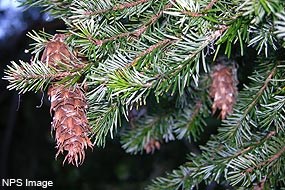
Douglas-fir (Pseudotsuga menziesii)This is, by far, the largest tree in the park. Old Douglas-firs can rival redwoods in size, reaching up to six feet in diameter. It is not a true fir, but it can look like one, and its scientific name translates to "false hemlock." At one time, people called it “Douglas spruce”; the Spruce Tree House at Mesa Verde National Park was actually named for a Douglas-fir. Mature Douglas-fir forms a large canopy that shades the ground below. Hunt around the ground and you may be able to find a Douglas-fir cone. No other conifer has such obvious three-pronged bracts that stick out of the scales. Each cone holds 20 to 50 seeds. In early fall, the cones release the winged seeds to drift to the ground. The dark forest that you see on surrounding ridges driving up Highway 1 through Olema Valley is made up of Douglas- firs. Your best views of Douglas-firs are on any trail or road on the south end of Inverness Ridge. 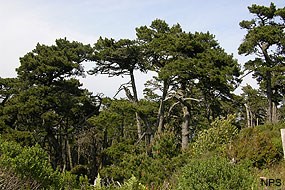
Bishop Pine (Pinus muricata)This is the only pine tree native to the park, but you can find it most everywhere on the north end of Inverness Ridge. Bishop pine takes on different looks depending on the toughness of the conditions. Near the ocean, lone bishop pines contort along the ground. Above the blowing salt spray, bishop pines can grow into trees with spreading branches that form a flattened crown. Straight and tall bishop pines crowd together into dense stands in patches burned by the 1995 Vision Fire. Hiking a trail through them is like traversing a tunnel. The branches point upwards and bushy clusters of needles whorl from the branches. In May, the trees look like candlesticks packed together—the ends of the branches hold candles of male cones that shed tons of yellow pollen grains to the air. The female seed-bearing cones attach to the trunk of the tree. Pitch seals these cones shut. Heat releases them, freeing the seeds protected inside. On a hot day you can hear the crackling as the pitch disintegrates, but a fire is the best way to release a crop of seeds. Bishop pines favor granitic bedrock and dry ridges. Your best views of dense bishop pine groves are along Mt. Vision Road, near the top of Limantour Road, Bayview Trail and Drakes View Trail. Pine Pitch CankerAs visitors drive along Limantour Road, they may notice that an increasing number of the bishop pine trees have tan needles at the end of their branches, and some trees are even dying. This is a result of pine pitch canker, which is a disease caused by the fungus Fusarium circinatum, which was discovered in a bishop pine forest at Point Reyes National Seashore around 2006. This has raised concern regarding the spread of F. circinatum through native stands of bishop pine and other susceptible host tree species beyond coastal California. Visit our Pine Pitch Canker page to learn more, including how you can help limit the spread of this disease. 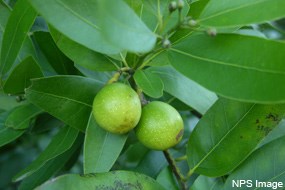
California Bay (Umbellularia californica)The spicy leaves are the name-sake for this tree (also known as Oregon myrtle). Rip off a piece and smell one—if it smells like seasoning, the tree is a California bay. In fact, the bay is in the same plant family as other delicious edibles like bay leaves, avocados, and cinnamon. The sparse leaves point this way and that off the branches, and the trunk bends gracefully to one side. Because they prefer moist soil, California bay can be found on trails on the east side of Inverness Ridge, such as Mt. Wittenberg Trail, Meadow Trail, and Bear Valley Trail. 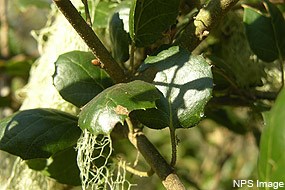
Coast Live Oak (Quercus agrifolia)This oak thrives near the coast. It is a "live" oak because the leaves live on the tree year round, unlike deciduous oaks like black oak and blue oak. The leaves are dark green on top and white and hairy underneath. They can dry out to a brown color and fall to the ground eventually. No other oak in California has leaves that curve backwards at the edges like a spaghetti rake. Like all oaks, coast live oaks drop acorns in the fall. The Coast Miwok collected these to thoroughly boil and then pound into meal. Scrub jays and California ground squirrels help the acorns out by burying them in their winter caches, essentially planting the acorns in the ground. Coast live oak grows most everywhere in the forested areas of the park. California Buckeye (Aesculus californica)This native buckeye has distinctive flowers and leaves. It produces bunches of white to pale pink flowers May through June. The flowers smell sweet, but eating any part of this plant destroys your red blood cells and can kill you. The flowers even poison bees that have not co-evolved with this plant. The leaves have five to seven leaflets that splay outward like a hand. Buckeyes are deciduous: they drop their leaves in late summer to early fall and new leaves emerge each spring. Seeds droop off the branches in summer and fall. You can see it along the Laguna trailhead near Clem Miller Environmental Center, the bottom of Bayview Trail and at the end of the Bear Valley Trail. Bush Lupine (Lupinus spp)This is one of the most common shrubs in the park. Its leaves are silvery-green and they whorl around the branches. In the spring, long stems of flowers curve towards the sky. Later the flowers will turn into fuzzy peapods. The fruits look like peapods because lupines are, like pea plants, legumes. Legumes naturally fertilize the soil. Bacteria that live in their roots can convert nitrogen in the air to a form that plants can use. People used to think that lupines did just the opposite, that they robbed the soil of its fertility. That’s why lupines were named for the wolf, which in Latin is lupus. Eight species of lupine grow in the park—the most common are yellow bush lupine (Lupinus arboreus) and dune lupine (Lupinus chamissonis). The best places to see them are Tomales Point Trail and Coast Trail out of Palomarin. 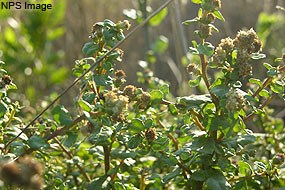
Coyote Bush (Baccharis pilularis)Coyote Bush does not have many distinctive features, except that if you’re in a shrubby area near the coast, you are probably looking at coyote bush. It is a large shrub with stiff bright green leaves. Come fall, the fruits ripen to cover the branches with white tufts of hair. Presence: Common. 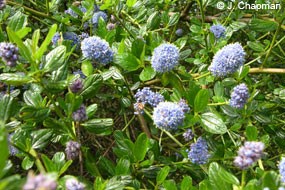
Blue Blossom (Ceanothus thyrsiflorus)Blue Blossom resembles a lilac. Spring finds clusters of blue flowers sticking out from the branches. Unlike a lilac, blue blossom’s dark green leaves stay on the branches year-round. Each leaf has three prominent veins that connect the base to the tip. The best places to view blue blossom are off Limantour Road, Bayview Trail, Drakes View Trail, and Muddy Hollow Road. |
Last updated: September 5, 2022
